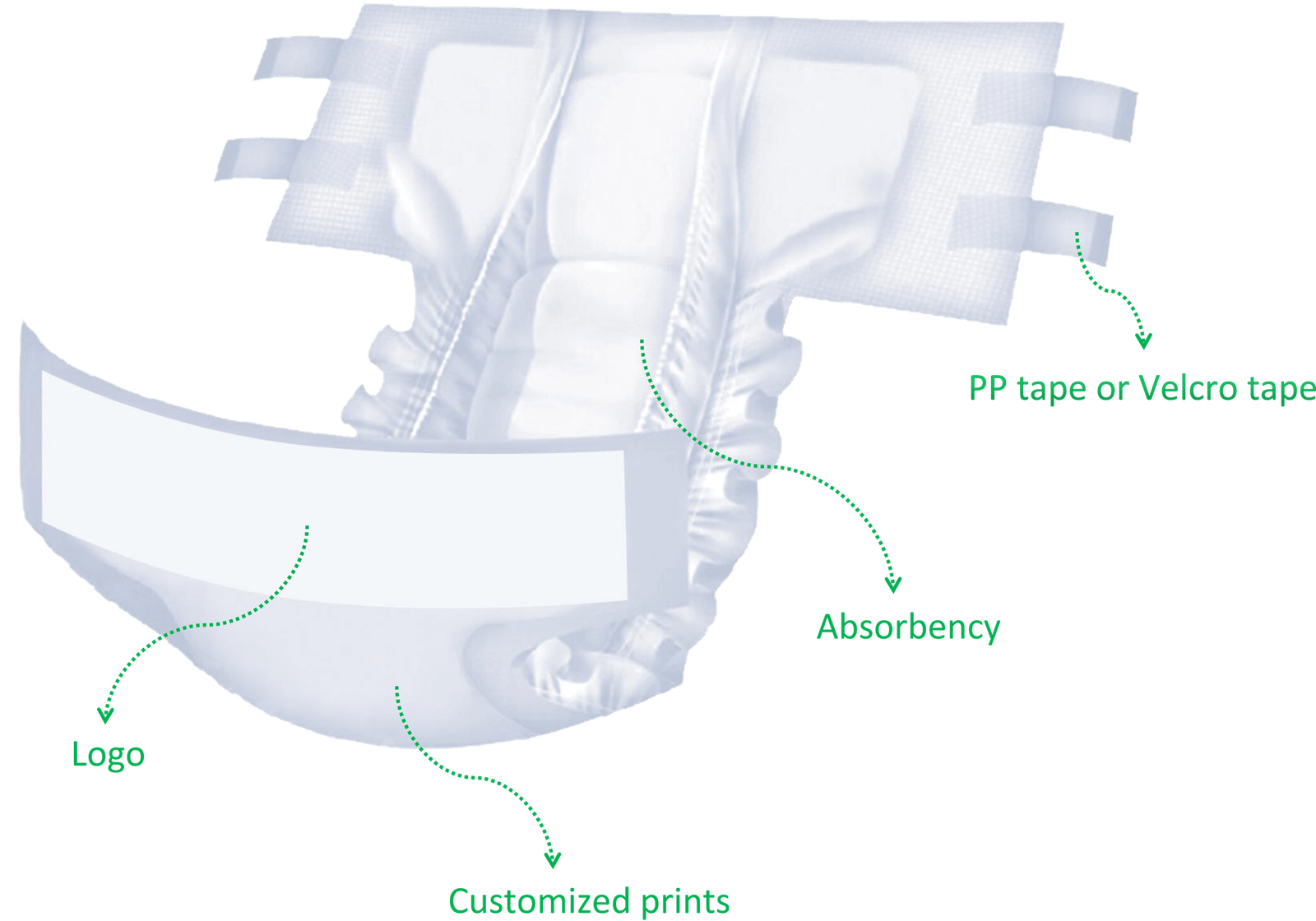The inception of wetness indicators in diaper technology marks a significant advancement in childcare products. These indicators, integrated into diapers, serve a crucial role in signaling the presence of moisture, thereby facilitating timely diaper changes. The evolution from traditional cloth diapers to modern disposable ones with smart features like wetness indicators highlights the strides made in enhancing the convenience and effectiveness of these essential childcare items.
1. Introduction to Wetness Indicators
Wetness indicators are designed to change color upon contact with moisture, providing a clear visual cue that the diaper is wet. This innovation not only simplifies the task of monitoring diaper status but also helps prevent the adverse effects of prolonged wetness exposure, such as diaper rash and discomfort for the baby. The development of these indicators is a testament to the ongoing efforts to merge practicality with scientific innovation, ensuring that diapers meet the dynamic needs of both infants and parents.
Understanding the functionality and benefits of wetness indicators is essential for appreciating their value in the realm of modern parenting. These features represent more than just a convenience; they are a proactive measure in maintaining the health and comfort of infants, thus exemplifying the thoughtful integration of technology in everyday childcare products.
2. The Science of Wetness Indicators
Delving into the science of wetness indicators, one discovers a fascinating interplay of chemistry and product design. These indicators consist of pH-sensitive dyes that react chemically to the presence of moisture, specifically urine, resulting in a color change. This reaction is not merely a visual effect but a chemical process triggered by the interaction between the dye and the wetness in the diaper.
The underlying principle of these indicators is their responsiveness to changes in the environment within the diaper. The color change, often from yellow to blue or green, occurs due to the acidic or alkaline nature of the urine, which alters the chemical structure of the dye. This change provides a visual signal to caregivers that the diaper is wet and needs replacing.
The incorporation of wetness indicators into diapers is a product of extensive research and development aimed at enhancing the diapering experience. This technology is carefully crafted to ensure that the indicators are safe for contact with baby’s skin while effectively fulfilling their purpose. The science behind wetness indicators is a compelling example of how innovative solutions can be harnessed to improve the quality of childcare.
3. Benefits of Using Diapers with Wetness Indicators
The advent of diapers with wetness indicators has brought about significant benefits for both babies and parents. For infants, the primary advantage lies in the maintenance of skin health. The indicators prompt timely diaper changes, thereby reducing the baby’s exposure to wetness and the associated risks of diaper rash and skin irritation. This proactive approach to diaper management helps in keeping the infant’s skin dry and healthy, contributing to their overall comfort and well-being.
Parents benefit greatly from the convenience and peace of mind that wetness indicators provide. The clear visual cue eliminates the guesswork involved in determining when a diaper change is needed, simplifying the diapering process. This feature is particularly valuable during the night or while traveling, as it minimizes disruptions and the need for frequent checks.
Furthermore, the psychological reassurance that comes from knowing one can promptly address the baby’s needs enhances the caregiving experience. The indicators act as a tool for ensuring that the baby remains in a hygienic and comfortable state, reflecting the broader benefits of using diapers equipped with this smart technology.
4. Impact on Early Childhood Development
The role of wetness indicators in supporting early childhood development is significant. Maintaining a clean and dry environment is crucial for preventing health issues like diaper rash, which can cause discomfort and disrupt a baby’s sleep and well-being. The prompt diaper changes facilitated by these indicators contribute to a healthier and more comfortable environment for the child.
Proper hygiene and uninterrupted sleep are foundational to the healthy development of infants. Wetness indicators in diapers play a pivotal role in ensuring both. By providing a clear signal for diaper changes, these indicators help maintain optimal conditions for sleep, which is essential for cognitive and physical growth. The comfort provided by a timely changed, dry diaper promotes better sleep patterns, directly benefiting the child’s developmental process.
5. Comparison with Traditional Diapers
When comparing diapers with wetness indicators to traditional diapers, several advantages become apparent. Traditional diapers, while often more affordable, lack the functionality and proactive health benefits that come with wetness indicators. The ability to immediately know when a diaper is wet can significantly reduce the risk of skin irritations and infections, thereby potentially lowering the overall cost of childcare through reduced medical treatments and happier, healthier babies.
However, the cost-effectiveness of diapers with wetness indicators is not just about the price point but also the value they add in terms of convenience and health benefits. Parents may find that the slightly higher cost of these advanced diapers is a worthwhile investment in their child’s comfort and well-being.
6. Environmental Considerations
The environmental impact of diapers with wetness indicators is a topic of growing concern. While these diapers offer significant benefits in terms of convenience and child care, the materials used in their production, particularly the chemicals involved in the wetness indicators, pose sustainability and disposal challenges. There is an increasing demand for diapers that are not only effective and convenient but also environmentally friendly.
The sustainability of wetness indicators involves assessing the lifecycle of the materials used, from production to disposal. Efforts to develop biodegradable and eco-friendly diaper options are on the rise, with manufacturers exploring alternative materials that reduce environmental impact without compromising functionality. The balance between the benefits of wetness indicators and their ecological footprint is a critical consideration in the ongoing evolution of diaper technology.
7. Choosing the Right Diaper with Wetness Indicators
Selecting the appropriate diaper is a decision that encompasses various factors, including the child’s size, skin sensitivity, and the specific features of the diaper, such as the type of wetness indicator. The market offers a wide range of diapers with wetness indicators, each boasting different designs and benefits. Parents must consider these aspects alongside their personal preferences and the baby’s needs to make an informed choice.
Guidance from healthcare professionals and recommendations from other parents can be invaluable in navigating the array of options available. Brands that are renowned for their quality and effectiveness in keeping the baby dry and comfortable often stand out. Evaluating the different products based on absorbency, fit, and skin-friendliness is essential in finding the ideal diaper with wetness indicators for one’s child.
8. User Experiences and Testimonials
The real-world effectiveness of diapers with wetness indicators can be best understood through the experiences and testimonials of those who have used them. Parents often share their insights on the convenience and reliability of these diapers, highlighting how they have simplified the diapering process and improved their child’s comfort. Feedback from caregivers provides a practical perspective on the advantages and any potential drawbacks of these products.
Expert opinions and endorsements also play a crucial role in shaping perceptions of diapers with wetness indicators. Pediatricians and childcare experts often recommend these diapers based on their benefits for infant health and caregiver convenience. Such testimonials reinforce the value of wetness indicators in modern diaper products, emphasizing their role in enhancing the quality of childcare.
9. Future Trends in Diaper Technology
The future of diaper technology, particularly concerning wetness indicators, promises further innovations and improvements. The ongoing demand for smarter, more user-friendly, and sustainable diaper solutions is driving research and development in this field. Anticipated advancements include more environmentally friendly materials, enhanced indicator accuracy, and additional features that cater to the evolving needs of parents and babies.
Market predictions suggest a continued growth in the preference for diapers with smart features like wetness indicators, driven by consumer demand for products that combine convenience with proactive health care. As manufacturers respond to these trends, the next generation of diapers is expected to offer even greater benefits, contributing to the well-being and development of infants worldwide.

